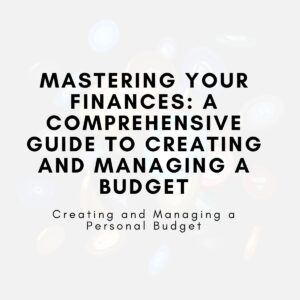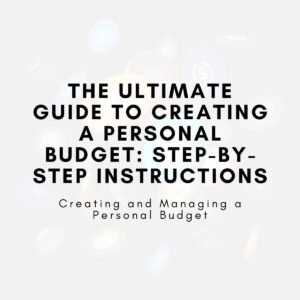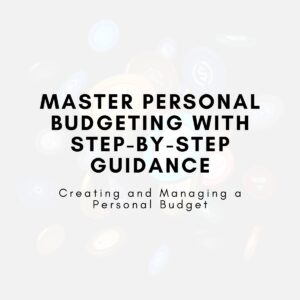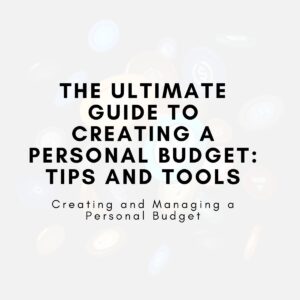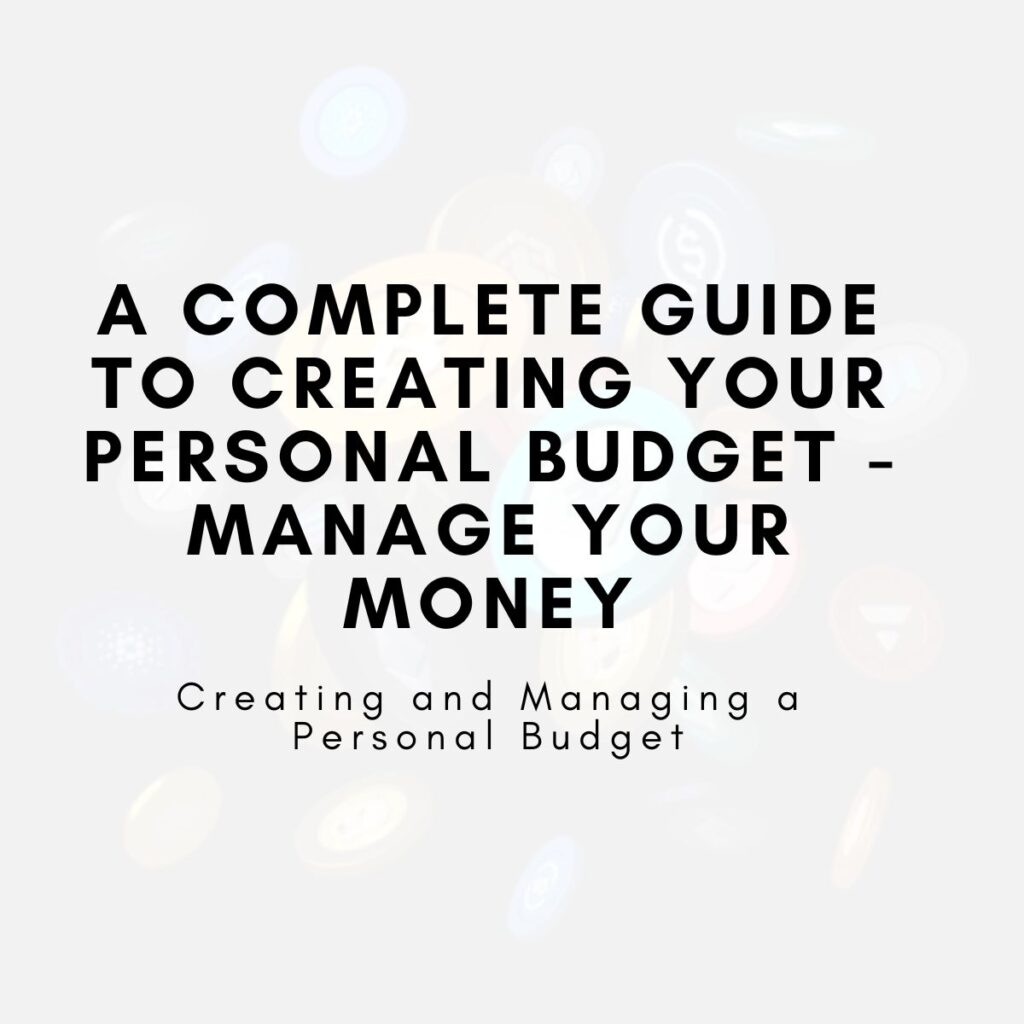
How do you create a personal budget and manage your money effectively?
Creating a personal budget is an essential skill for managing your finances. This guide will show you how to create a budget, track your expenses, and plan for future savings. With the right budgeting techniques, you can take control of your financial future and achieve your money goals.
Introduction
In today’s fast-paced world, managing your finances can often feel overwhelming, especially with numerous expenses to track and future financial goals to reach. However, creating a personal budget is one of the most effective tools you can use to take charge of your financial situation. A personal budget helps you understand where your money goes, where you can cut back, and how much you can save or invest. It’s not just a tool for paying bills—it’s a strategic approach to building a stable financial future. Whether you’re saving for a vacation, paying down debt, or planning for retirement, a well-constructed budget gives you a clear picture of your financial landscape, empowering you to make informed decisions. In this comprehensive guide, we’ll walk you through the process of creating a personal budget, introduce you to popular budgeting methods, and provide you with tips for sticking to your budget and achieving your financial goals.
Why Creating a Personal Budget is Crucial for Financial Health?
Understand Your Income and Expenses
The first and most crucial benefit of creating a personal budget is that it helps you clearly understand your income and expenses. Many people live paycheck to paycheck without truly knowing where their money goes each month. By creating a budget, you’ll have the ability to track your income sources, such as your salary, side hustles, or freelance earnings. You’ll also be able to break down your spending into categories—like rent, utilities, food, and entertainment—and see where your money is being allocated. For example, you might be surprised to find that you’re spending more on dining out than you realized, or that a subscription service is draining your account each month without adding much value. With this knowledge, you can make informed decisions to adjust your habits.
Achieve Your Financial Goals
A budget isn’t just about tracking expenses—it’s also a roadmap to achieving your financial goals. Whether you want to buy a home, build an emergency fund, or pay off debt, a budget helps align your spending with these objectives. For instance, let’s say you have a goal to save $10,000 for a down payment on a house in two years. By creating a budget and allocating a portion of your income to savings each month, you can easily track your progress and ensure you’re on the right path. Without a budget, you might unknowingly overspend on unnecessary items, delaying your ability to meet your goals.
Gain Peace of Mind
One of the often-overlooked benefits of budgeting is the peace of mind it provides. When you know exactly how much you can spend and how much you need to save, you can rest easy knowing that your finances are under control. This reduces stress and helps you feel more confident about your financial future. For example, if you’ve created a budget that includes an emergency fund, you’ll feel more secure in case of unexpected events like a job loss or medical emergency. Having a financial cushion can significantly reduce anxiety and help you navigate life’s uncertainties more easily.
The Basics of Creating a Personal Budget
Identify Your Income Sources
The first step in creating a personal budget is to identify your income sources. This includes your primary income, such as your salary, as well as any additional streams like side hustles, freelance work, investments, or passive income. For example, if you work a full-time job earning $3,000 per month and also make $500 per month from a side business, your total monthly income is $3,500. By knowing exactly how much you bring in, you’ll have a clear starting point for building your budget.
Categorize Your Expenses
Once you’ve identified your income, the next step is to categorize your expenses. This can be done by dividing your expenses into two main categories: fixed and variable. Fixed expenses are those that remain the same each month, like rent, mortgage payments, utilities, and loan repayments. Variable expenses fluctuate month to month and include things like groceries, entertainment, and transportation. For instance, your rent might be a fixed expense of $1,200 per month, while groceries and dining out might vary depending on your lifestyle. Breaking down your expenses will allow you to track and manage your spending more effectively.
Track Your Spending
Tracking your spending is an essential part of budgeting. Without this step, it’s easy to lose track of where your money is going. You can use budgeting apps like Mint or YNAB (You Need a Budget) to automatically track your spending or manually record your purchases in a spreadsheet. For example, if you’ve allocated $400 for groceries in a given month but end up spending $500, you’ll be able to identify the overspend and adjust future purchases to stay within your budget. Tracking your spending also helps you become more mindful of where your money is going and where adjustments can be made.
Different Budgeting Methods: Find What Works for You
The 50/30/20 Rule
The 50/30/20 rule is one of the simplest and most popular budgeting methods. It divides your after-tax income into three categories: 50% for needs, 30% for wants, and 20% for savings and debt repayment. This method is ideal for those who want a straightforward approach to budgeting without getting too caught up in the details. For example, if you earn $4,000 per month after taxes, your budget would allocate $2,000 (50%) for needs like housing and utilities, $1,200 (30%) for wants like entertainment and dining out, and $800 (20%) for savings or debt repayments. This method is easy to follow and offers flexibility in how you spend your money.
The Zero-Based Budget
A zero-based budget is a more detailed approach where every dollar you earn is assigned a specific purpose. The goal is to have a “zero balance” at the end of each month, meaning all your income has been allocated to either expenses, savings, or debt repayment. For example, if your monthly income is $3,500, you would break it down by assigning exact amounts to categories such as rent, utilities, groceries, savings, and debt repayment. The zero-based budget forces you to plan for every expense and can help you maximize your savings and minimize wasteful spending.
The Envelope System
The envelope system is a cash-based budgeting method where you divide your budget into different categories and store the allocated cash in envelopes. For example, you might have an envelope for groceries with $300 in it for the month. Once the money is gone, you cannot spend any more on groceries for the month. This method is effective for controlling spending in categories where it’s easy to overspend, like entertainment or dining out. The envelope system can also help you avoid using credit cards or relying on digital payments, encouraging you to be more mindful of your spending.
Using Technology to Simplify Budgeting
Budgeting Apps
Today, technology has made it easier than ever to create and stick to a budget. Budgeting apps like Mint, YNAB, and PocketGuard automate the process of tracking your spending and provide valuable insights into your financial habits. For example, Mint automatically syncs with your bank account and credit cards, categorizing your transactions so you can quickly see how much you’ve spent on groceries, dining out, and other categories. YNAB, on the other hand, helps you set specific goals and prioritize your spending. These apps can also send you reminders when bills are due and alert you if you’re overspending in a particular category.
Spreadsheets and Templates
If you prefer to have more control over your budget, using spreadsheets can be a great option. Google Sheets and Excel offer templates that allow you to create customized budgets that fit your specific needs. For example, you can create a spreadsheet that tracks income, expenses, savings, and investments, making it easier to visualize your financial situation. If you’re not sure where to start, both Google Sheets and Excel offer free budget templates that you can download and customize. These templates can help you get organized and stay on track with your financial goals.
Automate Your Savings and Bills
Another way technology can help you stick to your budget is by automating your savings and bill payments. For example, you can set up an automatic transfer from your checking account to a savings account each month, ensuring that you save a certain amount without even thinking about it. You can also automate your bill payments through your bank or service provider to avoid late fees and ensure your bills are paid on time.
Conclusion
Creating and sticking to a personal budget is one of the most effective ways to gain control over your finances and work toward your financial goals. By understanding your income, categorizing your expenses, and choosing the right budgeting method, you can create a clear path to financial success. Budgeting also helps reduce financial stress by giving you the confidence that you’re in control of your spending and saving. Remember, budgeting is not about restriction; it’s about making intentional choices with your money to improve your future. With dedication and consistency, you can achieve financial stability and set yourself up for long-term success.
Key Takeaways
- A personal budget helps you track income and expenses, making it easier to align your spending with financial goals.
- Choose a budgeting method that fits your lifestyle, such as the 50/30/20 rule or zero-based budgeting.
- Use apps and technology to simplify the budgeting process and stay on track.
- Automate savings and bill payments to make budgeting easier and more effective.
- Regularly review and adjust your budget to account for life changes and financial goals.
- Stay motivated by celebrating small wins and focusing on long-term financial success.

